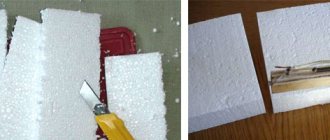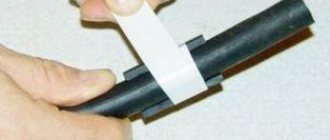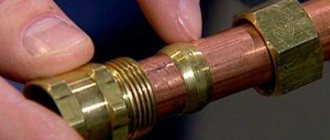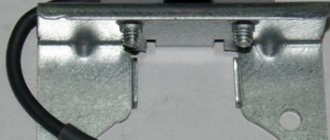To ensure regular hot water supply for their house or apartment, many owners install a gas boiler in the kitchen. The device is compact, does not take up much space on the wall, and even a teenager can figure out how it works.
Such water heating equipment will serve its owner "faithfully" for more than a dozen years, but only under the condition of correct operation and periodic cleaning. How to rinse and clean the gas water heater with your own hands at home (for example, the Zanussi GWH 10 Fonte Glass Rialto model)? For more information, see the article.
Why are the "insides" of the gas column clogged?
The reason for such contamination lies in the principle of operation of the device. The device heats water with gas, and therefore accumulations of soot and carbon deposits cannot be avoided. In addition, the incendiary element itself is very often contaminated, collecting soot on its wick.
But the real apocalypse comes when scale "settles" in the pipes of the water heater. It not only interferes with the normal operation of the equipment, but can completely disable it, completely clogging the plumbing part. The formation of scale in the heat exchanger is especially dangerous.
The heat exchanger is a collection of tubes placed above the gas burner. Water should flow through them constantly and unhindered, it is in them that it evenly heats up. When scale builds up in these pipes, hot water supply interruptions occur.
You may be interested in: 9 important questions when choosing a gas water heater
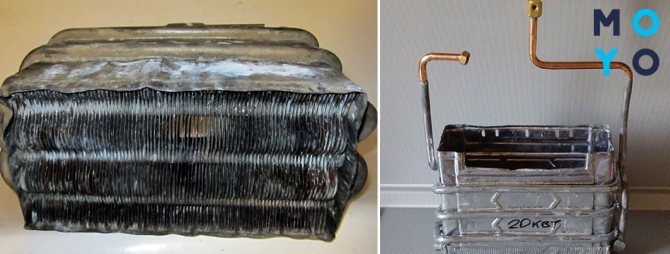
How to know when it's time to clean the column
Since technology heats water using gas, parts not only become covered with soot and carbon deposits, but scale settles on them. Due to the hardness of the water, when heated, salt accumulates on the elements: clogging the channels of the heat exchanger tubes, it disrupts the circulation. The heating rate decreases or becomes completely impossible.
What cleaning needs to be done at home:
- Cleaning the burner from soot and carbon deposits.
- Dust cleaning of internal elements.
- Heat exchanger from scale, soot, pipe flushing.
- Washing the plumbing.
- Checking the tightness of the seals.
- Checking the draft sensor for serviceability.
- Lubricate parts as needed.
How to understand that the product is clogged and needs cleaning:
- The column does not start or turns on for a short time and turns off.
- Frequent tripping of the RCD.
- The burner works as expected, but the water does not warm up well.
- Weak pressure from the tap.
The main causes of scale formation:
- The burner is constantly on.
- Heating exceeds 50 degrees.
It's time to cleanse: the first signs
You can determine that a gas water heater (for example, from Bosch) needs cleaning by 4 characteristic signs:
- The device stopped turning on or often goes out during operation... When there is 100% certainty that gas is supplied to the column without interruption, and water is supplied with a stable pressure, the reason for such independent shutdowns may be an excessive amount of burning on the incendiary element. The problem can be eliminated only by cleaning the burner.
- The thermal protection of the device is activated... To prevent the column from overheating, the equipment has a thermal sensor. It signals an increase in temperature, warning the owner of a malfunction. If this sensor is often triggered, it is worth cleaning the pipes from scale. Since limescale has good thermal insulation, it interferes with the normal cooling of the appliance.
- For no apparent reason, the productivity of the device has decreased... If the water begins to heat up more slowly or the pressure level has dropped significantly, you need to check the heat exchanger for scale and clean out the accumulated products of the column's activity.
So, it is clear with the contamination of the device, but how to clean the gas water heater from scale and soot when such a need arose? The answers are in the following sections of the article.


How to remove soot from a heat exchanger
We wrote above where the heat exchanger is located; before starting maintenance, it is advisable to remove it from the unit, having previously shut off the gas and water, by opening the hot water supply tap (the one located near the flow heater). Then, using a gas or open-end wrench, loosen the nut securing the tube to the water unit, unscrew it a little (a couple of turns will be enough). The contents must be allowed to drain through the mixer, which is left open.


Useful advice. Before cleaning the gas water heater from scale, prepare a special tool and means. The most convenient way to solve the problem is to use an aerosol agent to loosen boiled threaded connections. You can ask for the WD40 product at any car dealership or hardware store.
How to clean the gas column heat exchanger further:
- Unscrew a pair of union nuts, dismantle the assembly.
- Disassemble other elements, details that interfere with easy dismantling. Their number depends on the specific model, the design features of the column. In some cases it is necessary to remove the flue gas diffuser, in others - the ignition group, in the third - overheating and draft sensors. All parts may need to be removed.
- Cover the burner nozzles with a rag to prevent soot from entering.
- Take the heat exchanger to the bathroom, thoroughly clean it with a long-bristled brush to remove all soot, rinse and dry.
- Return the unit to its place, reassemble the unit in the reverse order described above.
Do not forget to install new sealing rings at the pipe joints. It is not difficult to clean the gas water heater, most of the time is spent on assembly and disassembly. Work should be done strictly according to the rules. If you are not sure that you will do everything as needed, call the wizard.
Useful advice. If the installation is clogged, you have already removed the heat exchanger, it makes sense to immediately rinse and clean the gas water heater from scale. The service will be more efficient and will not take a lot of extra time.
Before starting the unit, check it for leaks. To do this, open the water supply valve, wait for the filling of the heat exchanger from the open mixing valve. Then the feed is closed again, the assembly is inspected for the degree of permeability of its connections. In the absence of serious problems, the gas valve is opened again and the apparatus is started up for testing in standard operating mode.
Means for cleaning the gas column
The rules for caring for the gas water heater are described in detail in the instructions for the device and it can be dangerous to deviate from these requirements. If the water heater suddenly becomes clogged, use only the agents recommended by the manufacturer to clean it. They should also be indicated in the relevant paragraphs of the operating manual. And it is better to entrust the cleaning process to professionals. In this case, not only will the blockage be removed, but the warranty will also be preserved.
Important! Unauthorized reading with unauthorized means is hazardous to health! If during the process of descaling or burning one of the elements of the column is damaged and a gas leak appears, you must immediately call 104.
Only if the user understands all the possible consequences and accepts responsibility, you can clean the device yourself. What and how to flush the gas water heater (for example, the Ariston brand) from scale in this case? You can also use ready-made preparations or alternative methods.Which is better and more effective: "vigorous" chemistry or "grandmother's" cleaning, the comparative table will show:
| Solves the problem | Folk remedy | Chemical drug |
| Scale inside the heat exchanger | A mixture of 0.5 liters of hot water and 100 g of citric acid. | Calgon or Anti-scale (erodes the layers of scale inside the pipes). |
| A dense layer of carbon deposits (can only be removed from the heat exchanger, the gas part is cleaned by specialists) | Dilute table vinegar and warm water in a 1: 3 ratio. | You can use 7-10% hydrochloric acid or other strong chemicals. Important! Work requires accuracy: the product should never get on the skin or mucous membranes. |
How to descale the heat exchanger
Cleaning the heat exchanger of the gas column is one of the main service work.
To begin with, the knot is removed and prepared, than to clean it. The main options are:
- Special products for the care of equipment, which can be bought in specialized stores;
- A solution of citric acid (200 g of powder is taken for 1 liter of water);
- Acetic aqueous solution (9 parts of water, 1 part of vinegar, the essence is better to take 9%).
How to flush a gas water heater with any of the means:
- Pour the prepared solution into the heat exchanger - it is most convenient to do this using a watering can.
- Wait a few hours or leave the knot to soak overnight.
- Drain the solution down the drain.
- Rinse the heat exchanger with running clean water - you can use a water supply hose from the shower, the nozzle must first be unscrewed.
When cleaning the unit, it is impossible to exceed the concentration of funds - this will not increase the efficiency of maintenance, but it can damage the unit, cause corrosion and chemical reactions. Special means are used strictly according to the instructions - they cannot be left overnight, like vinegar.
Descaling: work procedure
To carry out such a manipulation, you can use both folk remedies and chemical solutions. Having cast your vote in favor of chemistry, you must follow the instructions exactly. If you choose citric acid or vinegar, then the work consists of the following stages:
- the gas water heater is turned off;
- the heat exchanger is disconnected from the rest of the elements by hand and removed from the wall, water is drained from it;
- at the same time connect a hose to the pipe that supplies water to the column to avoid leaks;
- with a pear, syringe or watering can, the resulting solution is poured into the pipes of the heat exchanger;
- now the heat exchanger body is lowered into a deep basin with the same mixture and left in this state for several hours or overnight.
After that, the part must be rinsed well under running water, connected back to the column (as an option, the column of the Ariston FAST R ONM model) and then start the device. Pressurized water will remove all scale, leaving the pipes perfectly clean.
Nuance: It is easy to check the efficiency of your work - just look at the color of the water: if it is transparent, then all the scale has come out.
Anyone who dreams of a new device will be interested in reading: Replacing an old gas water heater with a new one: 5 important points
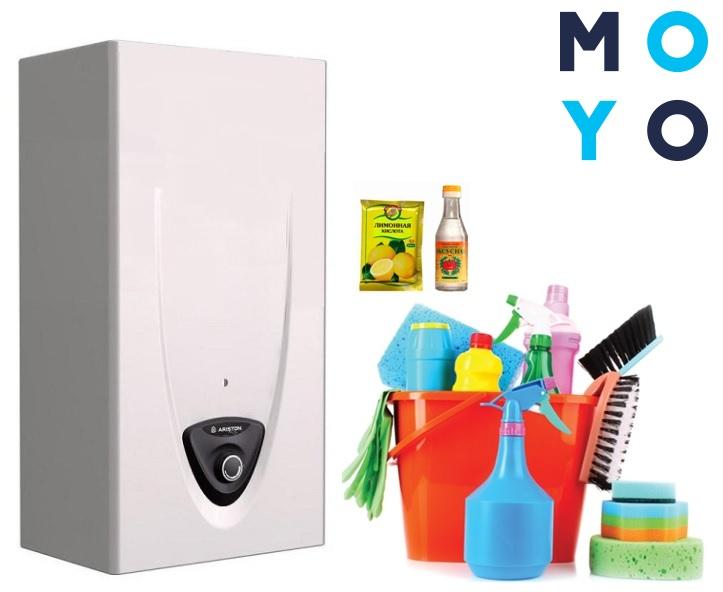

Removal order
With prolonged use of the heater in everyday life, sooner or later the question arises of how to clean the gas water heater at home. There are several ways to clean the water heater: with complete disassembly of the device, dismantling of the heat exchanger and without dismantling.
Cleaning the water heater when completely disassembled
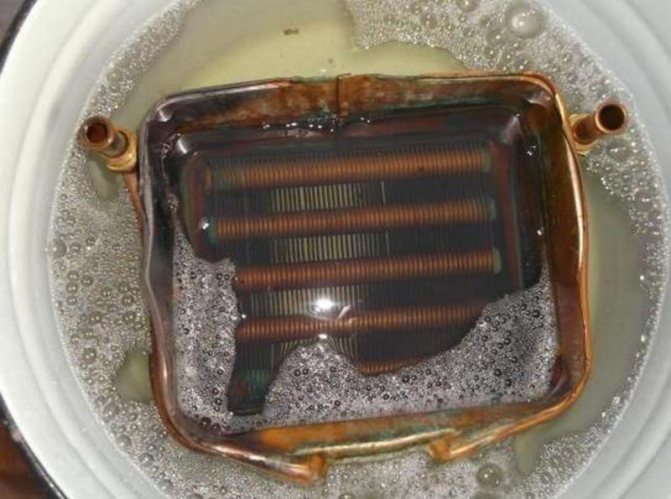

Rinsing the radiator in detergent
Disassembling the device is easy to do on your own, at home. To do this, you will need standard tools: a wrench, screwdrivers, pliers.
First you need to turn off the water and electricity supply, and then:
- unscrew the connection nuts;
- disconnect the pipe from the chimney;
- remove the water heater from the wall;
- unscrew two screws and open the case;
- remove the smoke box by disconnecting the wiring from the smoke sensor;
- disconnect the loop tube from the water block;
- release the pipe from the nut between the two self-tapping screws;
- unscrew the two screws on the flange to free the burner;
- to remove the burner, you need to slightly raise the heat exchanger;
- unscrew the self-tapping screws that attach the radiators to the wall of the water heater;
- disconnect the temperature sensors and completely remove the cover.
When the water heater is disassembled, it is necessary to do the following manipulations:
- flush the heat exchanger. To do this, it must be placed in a container with warm water and descaler, leaving the pipes outside;
- using a watering can, pour the solution into the heat exchanger, which will come out of the opposite tube together with the washed off sediment. It is necessary to continue this process until the pouring water is free of impurities;
- then rinse the radiator with clean running water.
Attention! When reassembling the gas column, it is recommended to replace all gaskets with new ones.
Dry the heat exchanger thoroughly before reinstalling it.
Cleaning the heat exchanger without dismantling
To clean the device at home without dismantling the heat exchanger, you need to arm yourself with a tool: pipe wrench, adjustable wrench, screwdrivers, rubber hose, as well as a descaler.
- Before working on the water heater, it is necessary to remove the casing and shut off the water supply.
- Next, open the hot water tap, and unscrew the supply pipe (it is copper) from the heat exchanger and take it to the side. Water from the heat exchanger will begin to leave through an open tap (about 1 liter, but its volume may vary depending on the model of the column).
- A hose is put on the inlet of the heat exchanger, which must be raised above the column and slowly pour in a descaler through it and leave for 2-3 hours. Use the product according to the instructions.
- Next, a bucket or basin is placed under the tap to collect dirty water and the supply from the water supply system to the column with a weak pressure opens. All accumulated lime should come out through the hose together with the water.
Attention! If the pressure has become good, the heat exchanger is clean, if the pressure is insufficient, then the procedure can be repeated.
Can the heat exchanger be cleaned without dismantling?
Immediately the answer is: "Yes, you can." To do this, it is necessary to remove the front protective panel and disconnect the heat exchanger from the pipe that supplies water to the gas column. A drain hose is connected in its place.
When these preparatory procedures are completed, any chemical agent (or folk composition, if desired) is taken and poured into the heat exchanger pipes through the inlet. It is worth filling the "insides" slowly, in a thin stream, in order to avoid a harsh reaction and pushing the product back.
In this form, the device is left for 2-3 hours. After the expiration of the time, you need to reconnect the hose and drain the waste water with scale and other impurities. Then turn on the column and check its operation.
The principle of operation of an instantaneous water heater
A gas water heater is a relatively simple device for heating water. Above is a heat exchanger connected to the water supply system. There is a burner underneath which is connected to a gas pipe.
In all modern models, the ignition of the burner is automated; only very old or faulty models are manually ignited. The latter are best repaired so as not to risk the health of the household and the integrity of the property.
The design is hidden by a protective casing, on the front of which the control unit is usually located. It regulates the maximum temperature of water heating, the amount of gas and other indicators of the device. On top there is a cap and a chimney through which combustion products are removed.
When water is opened in the house, the burner automatically turns on, the gas heats the water to the required temperature.The auto ignition is configured so that the column turns on only when the water pressure in the system is high enough. Another important indicator is good traction.
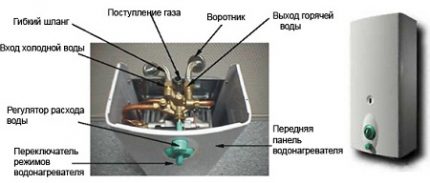

Before starting work on cleaning a household gas water heater, you need to get acquainted with the device device in order to properly disassemble it
We recommend: Disinfection and maintenance of whirlpools
The process of heating the water is accompanied by the formation of a hard sludge, which gradually accumulates inside the heat exchanger. The pipes become clogged with deposits, as a result, the quality of heating deteriorates, the operation of the instantaneous water heater becomes insufficiently efficient.
Regular column cleaning can help avoid these problems. In addition to scale, other contaminants can collect inside the device, it all depends on the quality of the water.
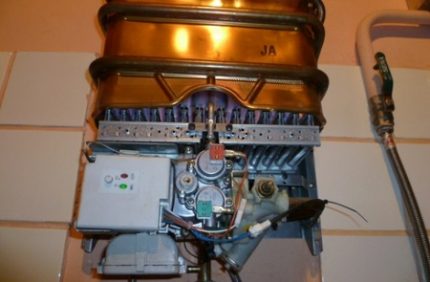

A household gas water heater is not particularly complicated: water moves through the heat exchanger pipe, the burner heats it up, the ignition turns on automatically
The following signs indicate that it is time to clean the column:
- the pressure from the tap with hot water is much weaker than the jet from the cold tap;
- the pressure is good, but almost immediately after turning on the column goes out;
- the device stopped turning on altogether, regardless of the pressure;
- there is insufficient heating of the flow in comparison with the previous state;
- the water heats up to the desired temperature, but too slowly.
Some malfunctions can also be observed in the event of a breakdown of the shut-off valve, which is installed at the inlet to the column. It does not hurt to first check it, and only then proceed to cleaning.
Removal of soot and grime
Cleaning the gas water heater (for example, the Bosch Therm 4000 O WR model) from combustion products, as well as from scale, should be entrusted to professionals, especially when the device is under warranty. You can only remove soot from the surface of parts on your own without disassembling the gas part. How to do it? The process takes 10-15 minutes and consists of the following stages:
- the gas supply is turned off and the upper case is removed;
- all internal elements are gently wiped with a rag or cleaned with a vacuum cleaner;
- the cover is installed back and the functionality of the device is checked.
If the gas wick starts to burn weakly, it means that the nozzle is clogged. It is located on the gas manifold, next to the pressure sensor. You can clean the nozzle with an ordinary thin wire and a stiff brush. Upon completion of work, be sure to check the element for gas leaks. To do this, lubricate the burner with soapy water (bubbles appear in the event of a leak).
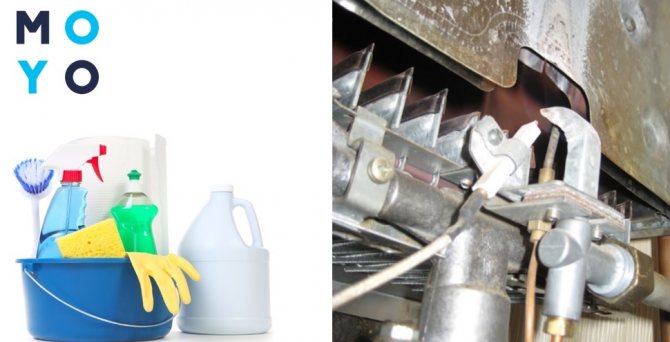

Why clean the gas water heater and how to understand that this procedure is necessary?
Tap water contains an impressive amount of mineral salts, which are modified under the influence of high temperatures, which leads to the formation of scale on the walls of the elements. As a result of narrowing the gaps of already narrow elements, malfunctions occur in the structure. You can understand that cleaning the gas column is necessary by the following signs:
- The device does not turn on at all or turns off on its own after working for a short period of time.
- The structure of the scale is such that its porous texture has thermal insulation properties, which is why the column cools down unusually slowly. Many models have thermal protection sensors that are constantly triggered.
- The performance of the appliance is reduced even if the burner is operating normally.
- Weakening of the pressure when leaving the column as a result of narrowing of the lumen of the tubes by layers of scale.
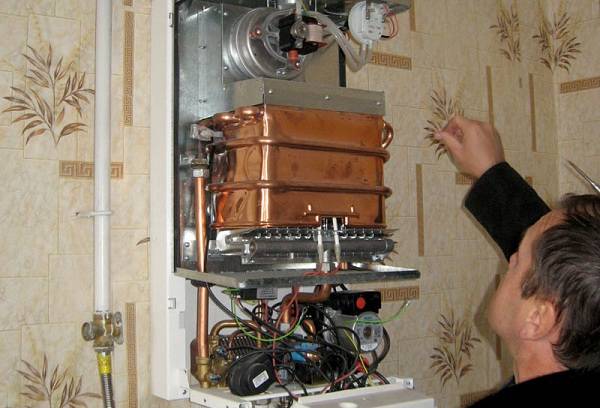

Tip: Before trying to clean the gas water heater with your own hands, it is necessary to shut off the water and gas supply on the pipes. Even if this can be done directly on the structure, it is better to play it safe and block the flow of substances on the pipes themselves.
Home craftsmen should remember that work requiring disassembly of the gas part of the column can only be carried out by specialists in this field. Any rash action in this area can lead to an accident.
Better prevention than cleaning
Prevention is necessary to prevent scale, which is the main scourge of gas water heaters (for example, such as Zanussi columns). It appears not only as a result of salt deposits from hard water, but also as a result of the constant high temperature in the appliance. To keep the pipes clogged with this "filth" as little as possible, it is necessary to set the optimal temperature regime.
Another way to prevent limescale is to install water filters or electric softeners. They keep harmful salts out, allowing the heat exchanger tubes to last longer. However, the cleanliness of the filter and the electric softener must also be monitored.
You may be interested in: TOP-10 gas water heaters of 2017
Preventing the appearance of limescale
It is obvious that scale is primarily formed in the heat exchanger. It is important to warn it - if the radiator gets clogged, it will damage the device.
We recommend: How to clean metal from rust: the most effective ways
Water hardness varies by region. It is less in the northern regions, but gradually increases towards the south. Residents of regions with hard water should pay attention to softeners. They are installed at the entrance of pipes to a house or apartment. This is useful not only for the column, but in general for devices in which there is a heating element.
If the water situation is not so dire, then such drastic measures are not required. It is enough to install special filters.
You can flush the system with formic acid or phosphoric acid. With such processing, a properly prepared solution is very important: 1 mm of scale accounts for 1%! Acid. However, the total concentration should not exceed 10%! Stronger solutions can damage surfaces.
Advice: in order for the column to serve as long as possible, carry out preventive maintenance from the very beginning of using the device or from the moment of service. The optimal frequency of the procedure is at least 1 time per year.


What causes the heat exchanger to clog
Along with other water heaters, such as a kettle, boiler, washing machine and iron, the gas water heater is also a victim of scale. It is important to know that it consists of a flow and a gas part. It is strictly forbidden to interfere with the work of the second one; in case of any suspicion, you need to call the gas service, which specializes in this.
The heat exchanger is the part of the device that is covered with scale, but what is it, let's figure it out.
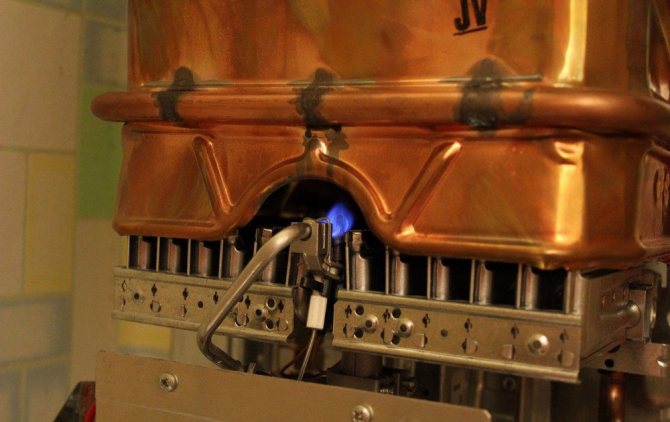

Scale is a solid residue that forms from dissolved salts and metals in hard water. It begins to stand out at a time when the water temperature rises above 80 degrees. We ourselves create this problem, because such hot water is absolutely useless. To swim or wash the dishes, you need a maximum of 42 degrees, for the laundry to be washed - 60 is quite enough. But we heat the water until it boils completely, after which we dilute it with cold water along the way.
This layer overloads the system and makes the gas flow rate higher than normal. This is because carbonates and sulfates that form deposits have less thermal conductivity than metals. To warm up the water, the walls are heated first, which subsequently share heat. But through scale deposits, this task is complicated, which leads to overheating of the metal walls and to the prerequisites for their further destruction. The most dangerous thing is that scale builds up even in thin pipes, and they can clog.
Column cleaning methods at home
Since scale also appears in a non-separable tubular coil, the only way to remove it at home is to use chemicals that do not have a harmful effect on the material of manufacture of the equipment.
There are two types of heat exchange chambers: copper and stainless steel. Copper is characterized by a higher thermal conductivity, but the cost is higher than stainless steel, and the service life is only up to 12 years. Stainless steel transfers heat worse, but is cheaper, while its service life is longer - up to 20 years.
Both metals are not vulnerable to corrosion in water and have approximately similar chemical resistance, therefore, similar methods and means are used to clean stainless steel and copper heat exchangers.
There are two ways to clean your gas water heaters at home:
- Chemical reagents. When using them, once a year, it is necessary to descale the heat exchanger without removing the coil from the housing and once every two years, if you take out the heat exchanger and at the same time clean it from salt deposits and soot.
In this case, the following reagents are used:
- Anti-scale. The most popular products are Anti-scale, Detex, Master Boiler, Cillit Bang. You can use descaling agents in a kettle, washing machine, dishwasher, iron. Before pouring into the device, the concentrated mixture must be dissolved in the proportions indicated on the package.
- Hydrochloric acid HCl. Formed by mixing water with hydrogen chloride. Since any acid corrodes metal elements, special additives and inhibitors are added to the saline solution, which prevent the chemical reaction of decomposition of stainless steel or copper.
- Acids. Phosphoric acid solution (Н3РО4) is an effective agent for cleaning the heat exchanger coils from oxides, the optimal ratio is 1 to 6. Aminosulfonic acid (NH3SO3), dissolved in water, has a less destructive effect on metals. Household acids - citric (C6H8O7) and acetic (C2H4O2) have less negative impact on human health and metals, however, this significantly increases the cleaning time and decreases efficiency.
- Electromechanical methods... To clean the heat exchanger, you can use a mechanical option for supplying a cleaning solution under pressure; in a country house, you can use a mini-high-pressure washer for this, while the water heater must be disassembled, while the soot must be removed.
Speed up the process using a small-sized centrifugal electric pump or vibration pump. To do this, connect the pumping equipment to the inlet of the coil and the tank with the cleaning solution, and drain the liquid from the outlet into the main tank with anti-scale, thereby ensuring circular circulation of the mixture.
The use of an electric pump is a fast, high-quality and reliable cleaning option, thanks to which the liquid under high pressure flows through the coil, which leads to effective scale detachment.
Cleaning principles
To clean the column from scale, you need to understand the features of assembling the device, study the instructions, prepare a cleaning solution, a set of tools for removing screws and tightening the valves.
To clean the unit you will need:
- keys set;
- screwdrivers;
- rubber hose up to 1 m;
- set of paronite gaskets;
- funnel;
- folk or chemical descaling agents.
In the first element, water is heated, which, when the burner wick is started, comes from the water supply. Combustion products escape through the ventilation opening.
Elements must be cleaned according to the algorithm:
- heat exchanger;
- water supply unit;
- jets;
- other constituent components.
The descaling process is not difficult, the main thing is to properly tighten the membrane during the assembly process so that it is springy, but does not hang down or is tightly fixed. When cleaning the gas column for the first time, it is recommended to act under the supervision of a specialist.
How often to clean the column
The gas water heater should be serviced at least once every 2-3 months, visually inspecting the surface of the parts.Every six months, clean the unit with folk remedies or household chemicals.
Do I need to remove and disassemble the column
In order to comprehensively flush the heating device, it is necessary to remove and disassemble it. Open the case, inspect the filter, membrane, radiator, clean using chemistry or folk methods. To reduce the appearance of limescale, which will make it possible to disassemble and clean the entire column less often, you can flush the radiator every 2 months without removing it.
Cleaning the heat exchanger without removing
For the procedure you need:
- Disconnect the water supply pipe.
- Put a rubber hose on the outlet.
- Open the tap and drain a small amount of liquid, not more than a liter.
- Use household powder for cleaning rust, pre-dilute the mixture with hot water.
- Pour the solution into the pipe with a thin stream. Leave the radiator in this state for 2 hours.
- Open the tap, drain the contents, flush the structure.
It is recommended to use strips of corrugated paper (wiggle or not) for checking. But the fire of a lighter or candle can be dangerous, especially if there are problems with fuel leakage.
Frequency of cleaning
Many users wonder how often a gas column needs to be cleaned in order for it to function properly. It must be borne in mind that the frequency of cleaning such equipment is in direct proportion to how often the water heater is used.
Also, parameters such as:
- pressure level and degree of water hardness;
- the state of important nodes;
- the presence of a layer that protects against scale;
- technical condition of smoke extraction.
In some certain operating conditions of the same type of flow-through radiator, cleaning is required after six months. In other conditions - after three years.
Regarding routine maintenance cleanings, it is recommended to carry out them at intervals not exceeding one year.
Device
Before you start cleaning, you need to figure out what elements the device for heating water consists of.
Heat exchanger
The main part of any gas column is a heat exchanger, which many call a radiator. Outwardly, it looks like an ordinary iron box. During operation of the device, warm air, generated in the combustion chamber, enters the box.
Several tubes are installed around the heat exchanger through which water is passed. It is during the circulation of the liquid around the box that it heats up.
Igniter
The igniter is responsible for the operation of the gas system, and therefore must burn continuously. The main function of this column component is to ignite the main burner. If the igniter does not burn, the burner will not ignite and the water will not start to heat up.
There are several reasons why the igniter may not burn:
- breakage of the sensors responsible for traction;
- clogged gas filter;
- poor chimney draft.
Main burner
The main burner is responsible for heating up cold water in the system, which is ignited by a burning igniter. If the burner breaks down and stops working, then the column will not heat the water.











